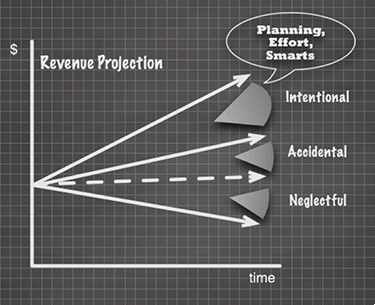In a recent SCN Blog, Jeff Stoebner, CEO of AVI Systems talked about the difference between growing and increasing, citing Randy Klein of Crestron as inspiration. For me, the takeaway is that growing a business is something you do intentionally while increases are what happen to companies in spite of themselves. “We grew 20 percent this year!” said the guy who is now paying for our drinks. One of us replies, “Congratulations, what did you guys do?” Answer, “Uh, we got this one big job…” (Cue sad trombone.) Other lucky owners may attempt to connect the “one big job” back to a marketing initiative, but that begs the question “Then, why don’t you have more jobs like that?”
The lesson here is to have intentional results, which is much different from letting the results just happen or worse, being neglectful.
Accidental growth—like finding a $100 bill in the parking lot—deserves a small celebration (and a round of drinks), but it’s a little bit of an embarrassment in that it wasn’t an intentional—‘everything we’ve planned lead to this’—kind of thing. Earlier this year, I was working with a client on their 2015 forecast. Without any hesitation, the owner announced that he expected to grow 10 percent next year. It’s a good guess: The company’s client base according to market research will grow 7 to 8 percent, and demand for his product is up compared to competitive products. This is another kind of accidental growth: riding the market wave. Unfortunately waves have nodes. Accidental growth is often followed by unexplained declines. If you can’t explain the ups, you probably won’t anticipate the downs. The combination of up and down over time is stagnation: the average of a sine wave over one complete cycle is zero.
My challenge response to my client was: if you know that you should grow ten percent without changing a thing, how much could you grow if you tried? That is, identify the target customer and apply effort to branding, marketing, outreach, pricing, productizing, systems, and customer maintenance? Is the potential business out there? Do we know what they want? Can we rally the resources? And most importantly, will the team be on board with this? When managers finally get down to execution, the one thing that holds many companies back is employees that don’t support the initiative. As a business consultant, I can tell you that most of my advice and coaching has to do with getting employees to work the plan, but with their support, you can grow intentionally. [Ed Note: Check out SCN’s December print edition to read Tom Stimson’s advice about driving change in employees and getting them to work the plan.]
We will take dumb luck whenever we can get it, but it doesn’t fit well into a serious business plan. As we learned at InfoComm AVEC this year, your products and services have to connect to your customer segments, infrastructure, messaging, pricing, skills, and resources—at the same time. And, involving employees in developing this roadmap is the key to earning their acceptance and sustained effort. The hardest part of growing a company is not finding opportunity (it’s all around us) or even coming up with a plan (aren’t we in the planning business?). It’s getting your people on board with the idea and this includes you.
The lesson here is to have intentional results, which is much different from letting the results just happen or worse, being neglectful. It is one thing for an eager owner or sales manager to declare that the company will grow by x percent next year; sustainable growth comes from planning and foresight across the entire company. There are no shortcuts, and there can be no dark spots in the plan. Success or failure is a company outcome.










